Why you can trust Tom's Hardware
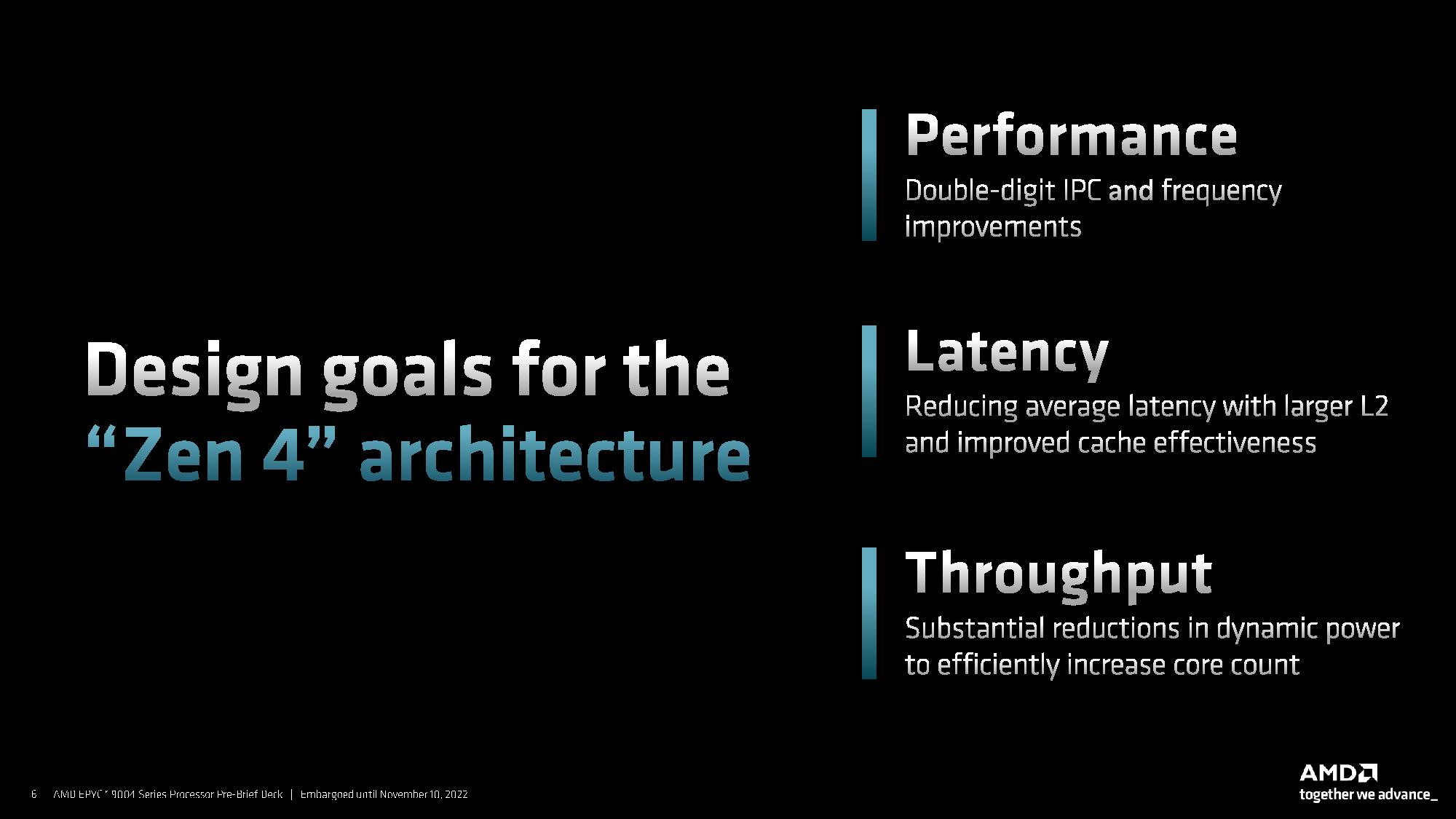

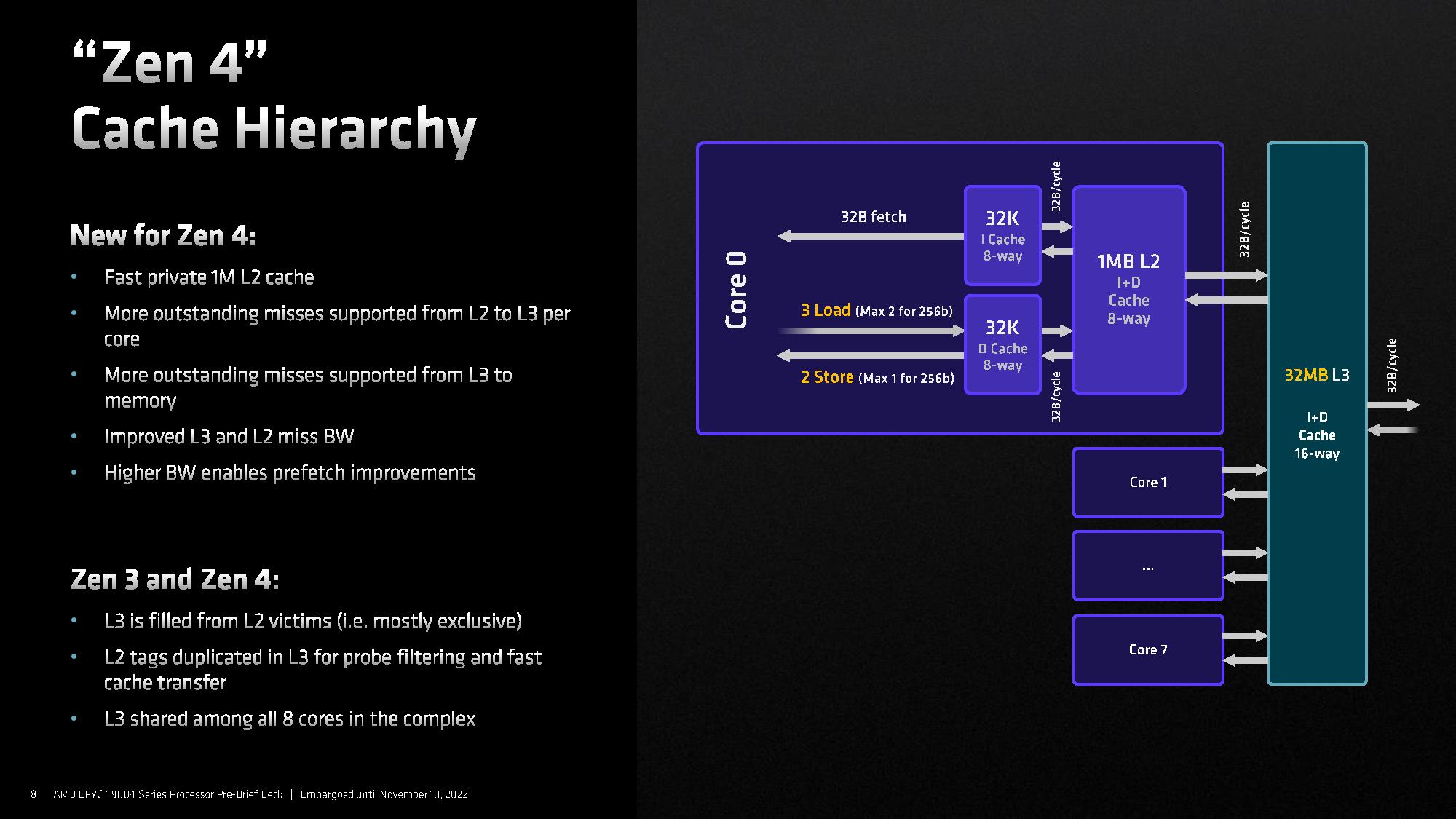
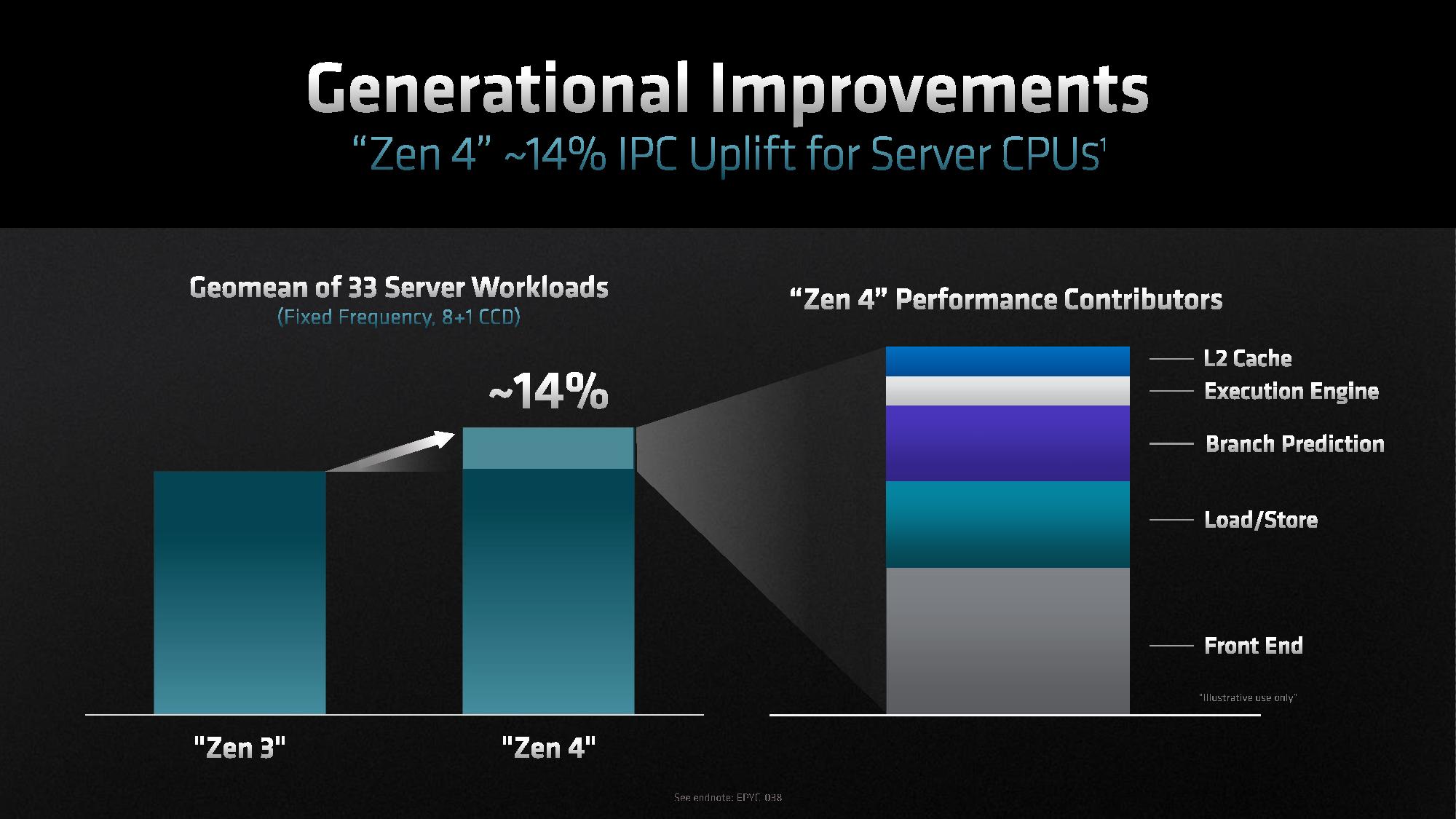

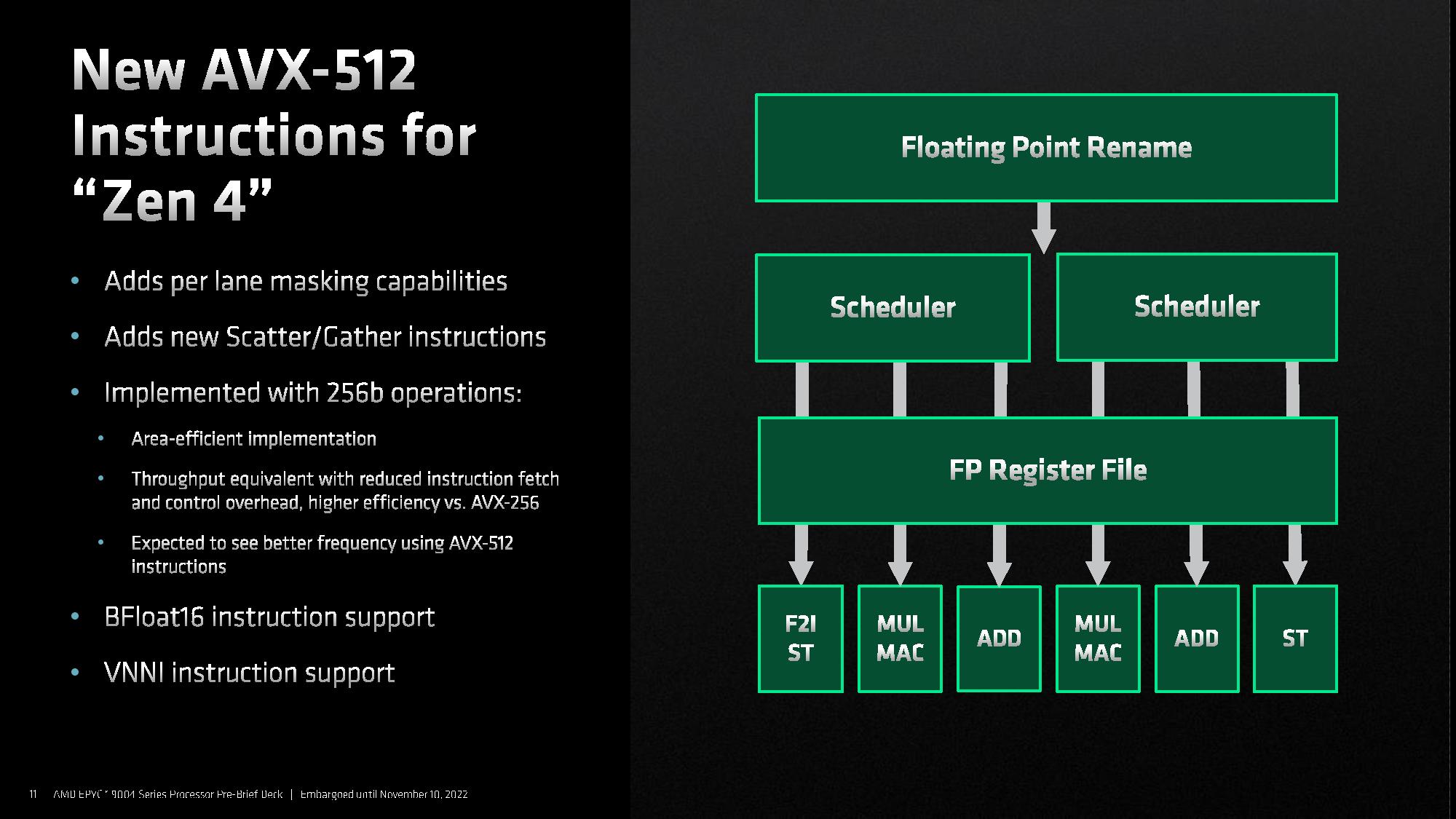
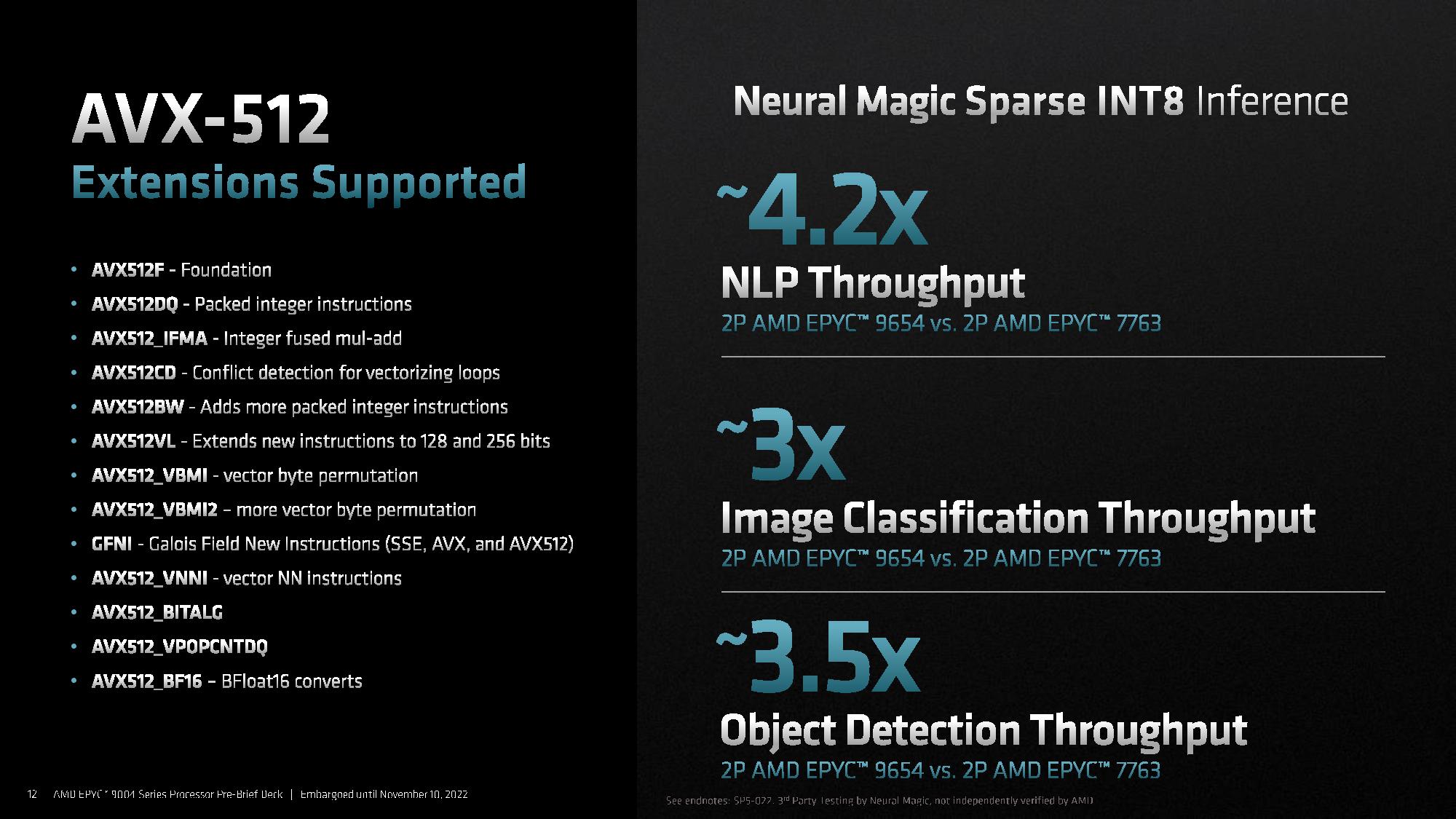
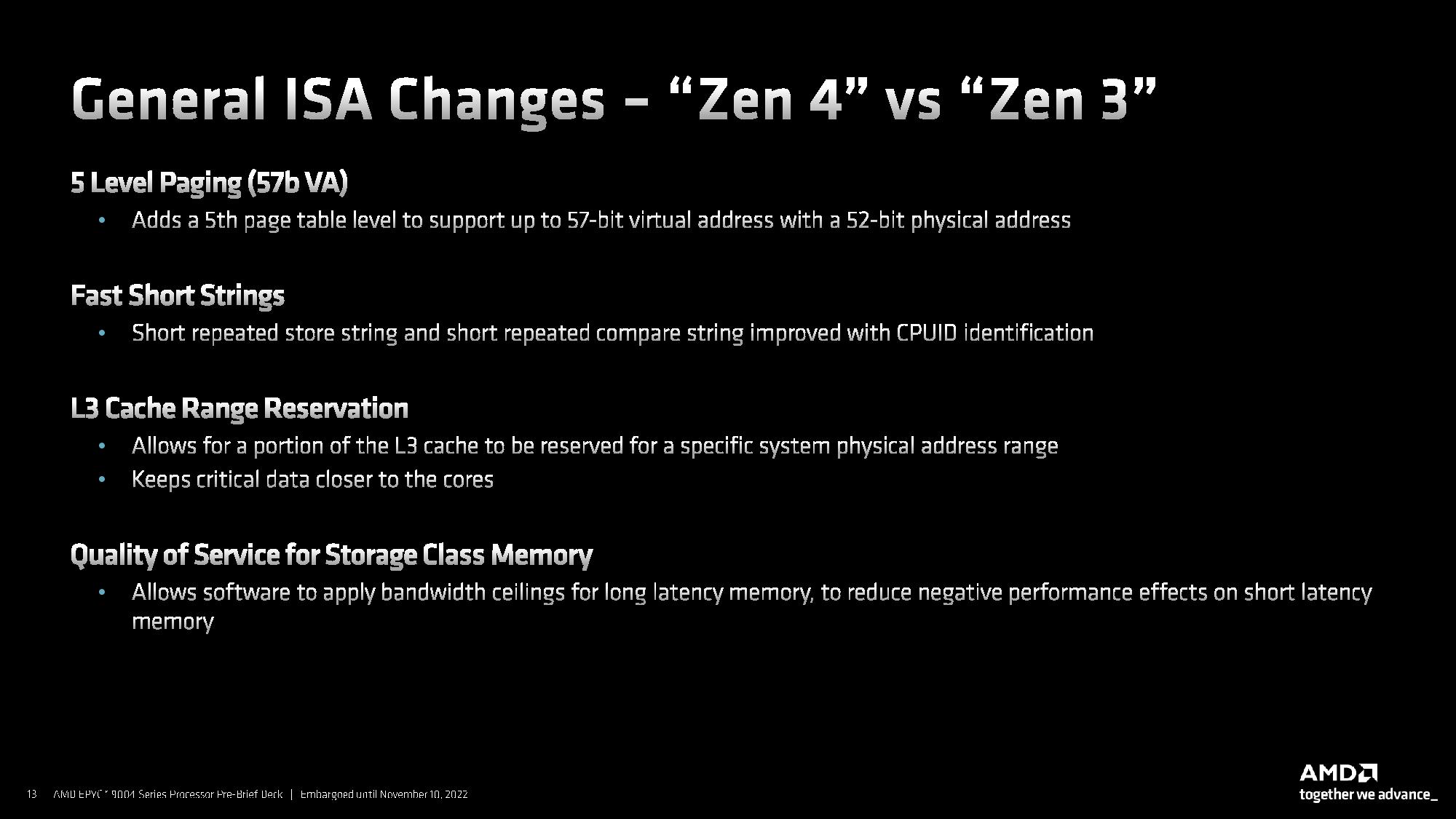
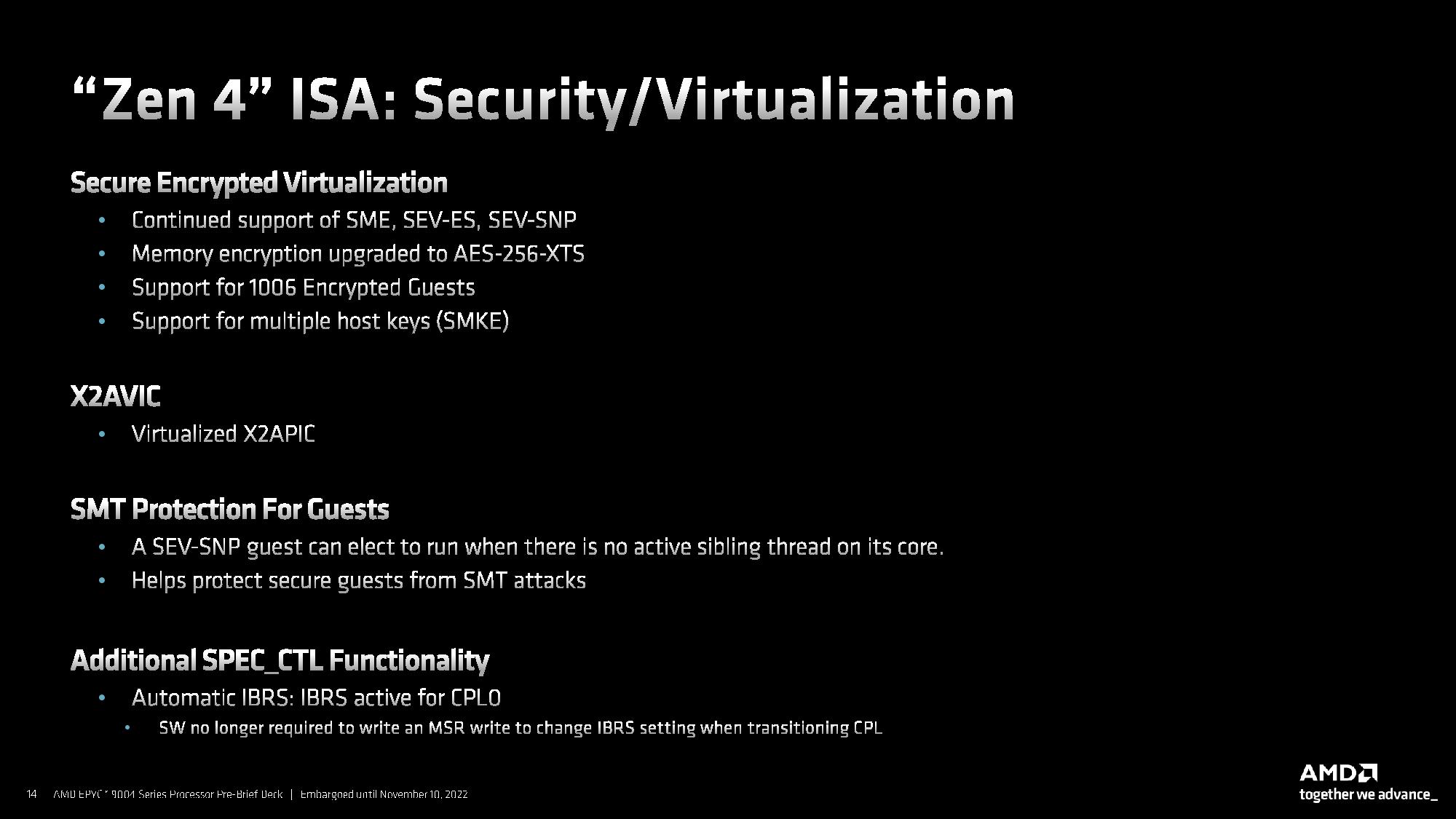
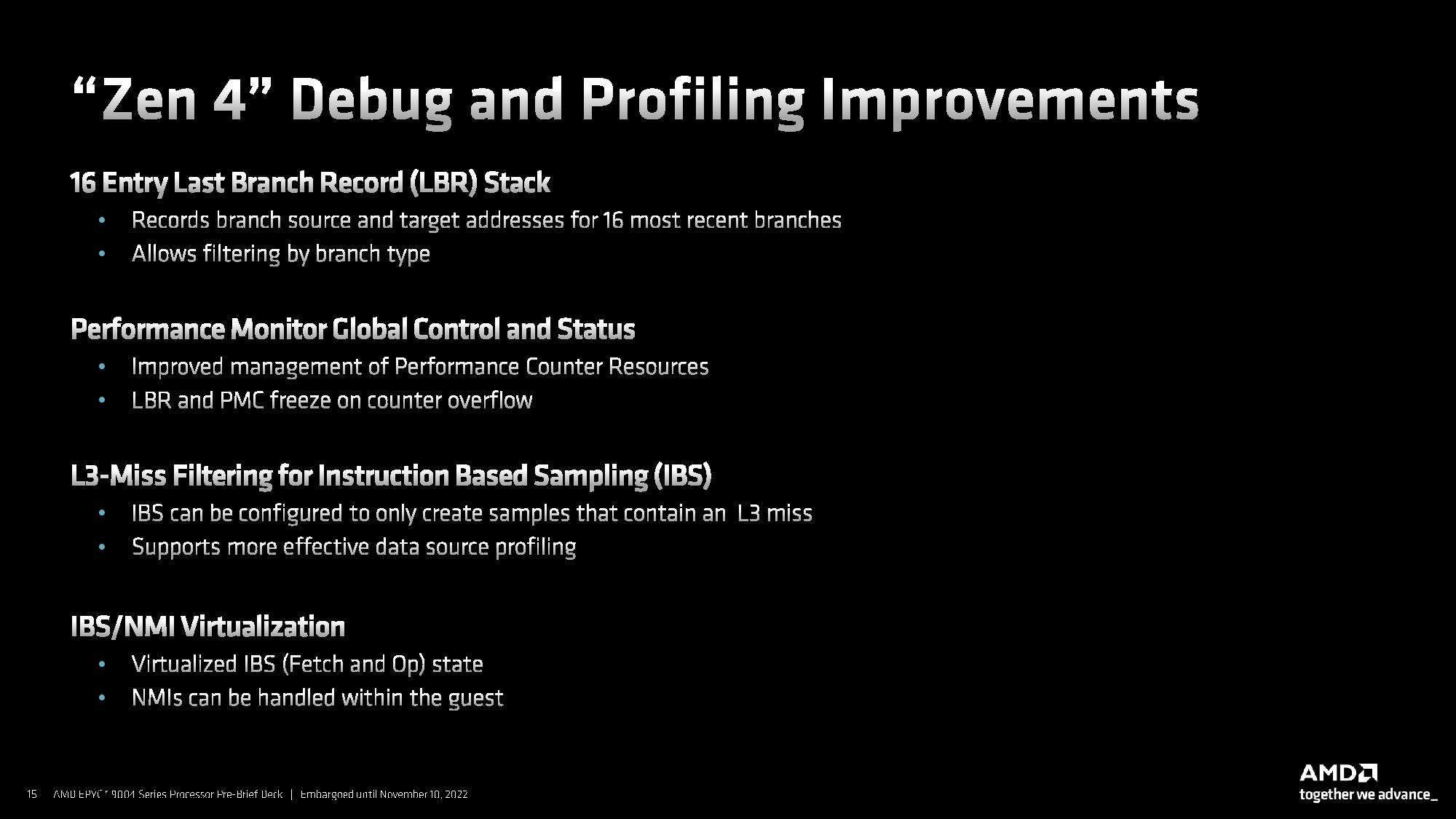
The Zen 4 architecture first debuted with the company’s Ryzen 7000 processors, so it is now a well-known quantity. AMD says the Zen 4 architecture is an iterative advance over Zen 3. However, Zen 5, which arrives in 2024, will be a grounds-up redesign.
AMD made several advances, but widening the front end to better feed the execution units and improving branch prediction account for 60% of the IPC gain. AMD also increased the op-cache by 1.5x, moved to a two-branch-per-cycle prediction, improved the load/store units, and doubled the L2 cache capacity. The increased L2 cache capacity results in an additional 2 cycles of L2 latency and adds 4 cycles to L3 latency. AMD says this increased latency isn’t too detrimental because the increased cache capacity provides higher hit rates that largely offset the penalty.
AMD has enabled support for AVX-512 instructions, VNNI, and BFloat 16, among a host of other AVX-512 instructions that match the instruction set supported by Intel’s Ice Lake/Cooper Lake. AMD describes its AVX-512 implementation as a 'double-pumped' execution of 256-bit wide instructions. This means that it actually takes two clock cycles to execute an AVX-512 instruction (256b data path), but the architecture executes the issue and retire for AVX-512 in one operation.
AMD’s approach provides compatibility with AVX-512 and still boosts performance. This approach also saves die area and defrays the frequency and thermal penalties typically associated with Intel's processors when they execute AVX-512 workloads. In other words, clock rates won’t drop dramatically (they can increase in some cases), and temperatures won’t skyrocket when the processor executes these types of workloads.
AMD’s AVX-512 implementation results in lower throughput per clock than Intel's method, but the higher clocks obviously offset at least some of the penalty. AMD says AVX-512 provides a 30% increase in multi-core FP32 workloads over Zen. Genoa also offers increases of 4.2x, 3x, and 3.5X in NLP, image classification, and object detection throughput by leveraging INT8.
AMD says the net effect of its Zen 4 architectural enhancements is a 14% increase in IPC over Zen 3. Our own measurements generally agree with those claims, though it is noteworthy that IPC can vary by workload. AMD specc’d the IPC gain at 13% for the Zen 4 architecture when it released the desktop PC Ryzen models, but has apparently reached a 14% value with the different mix of server workloads it used to quantify IPC uplift for Genoa.

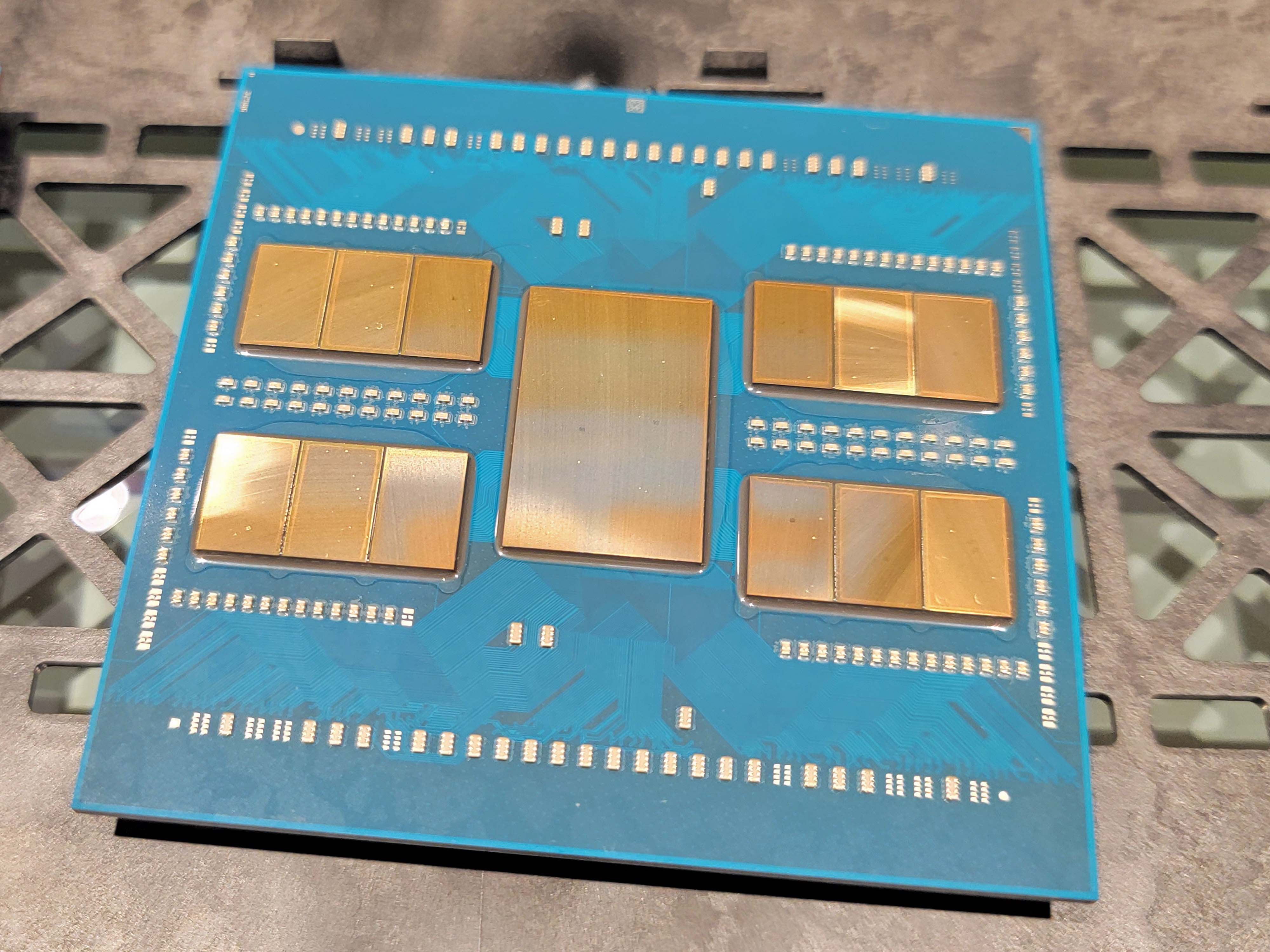
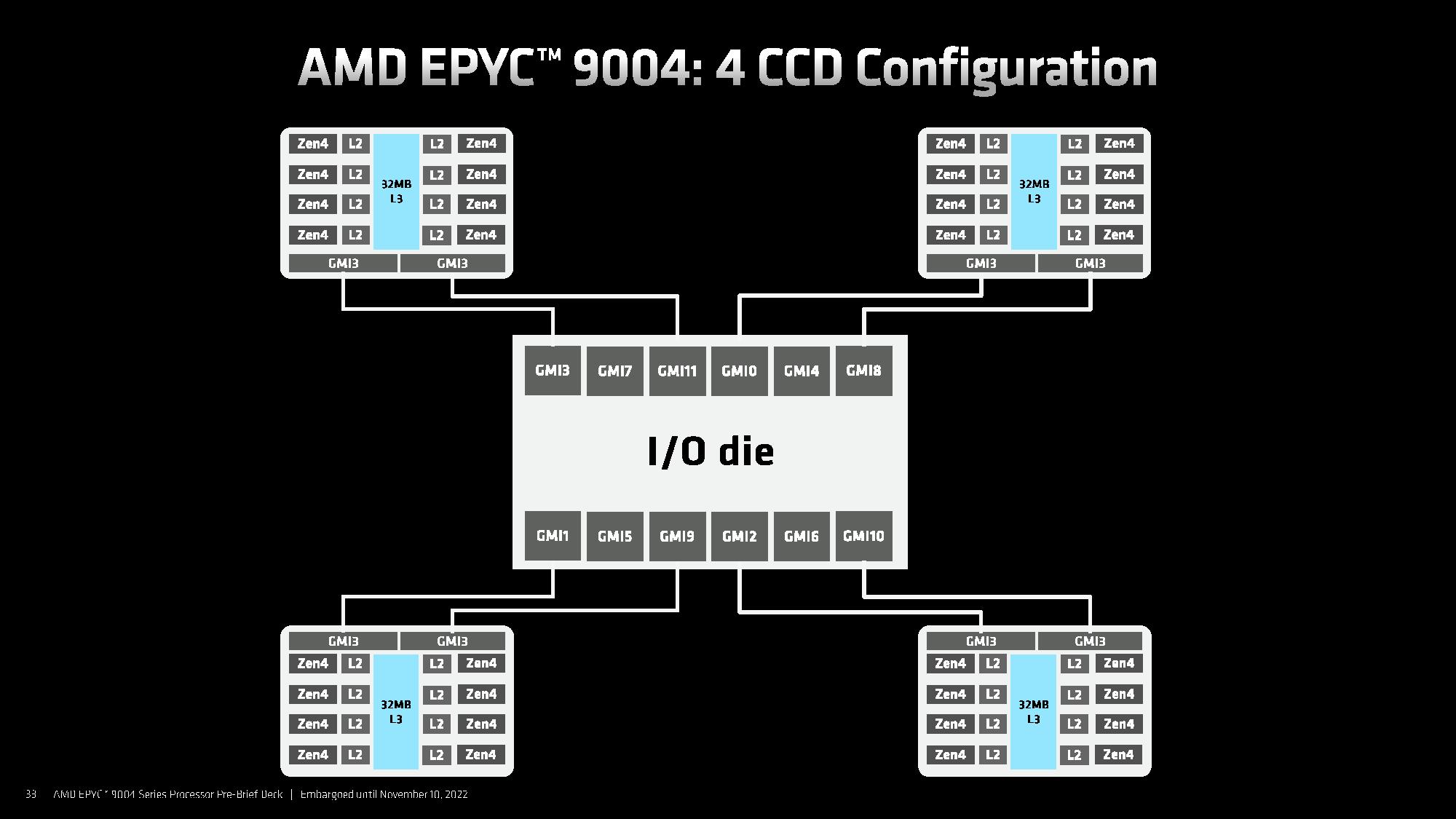

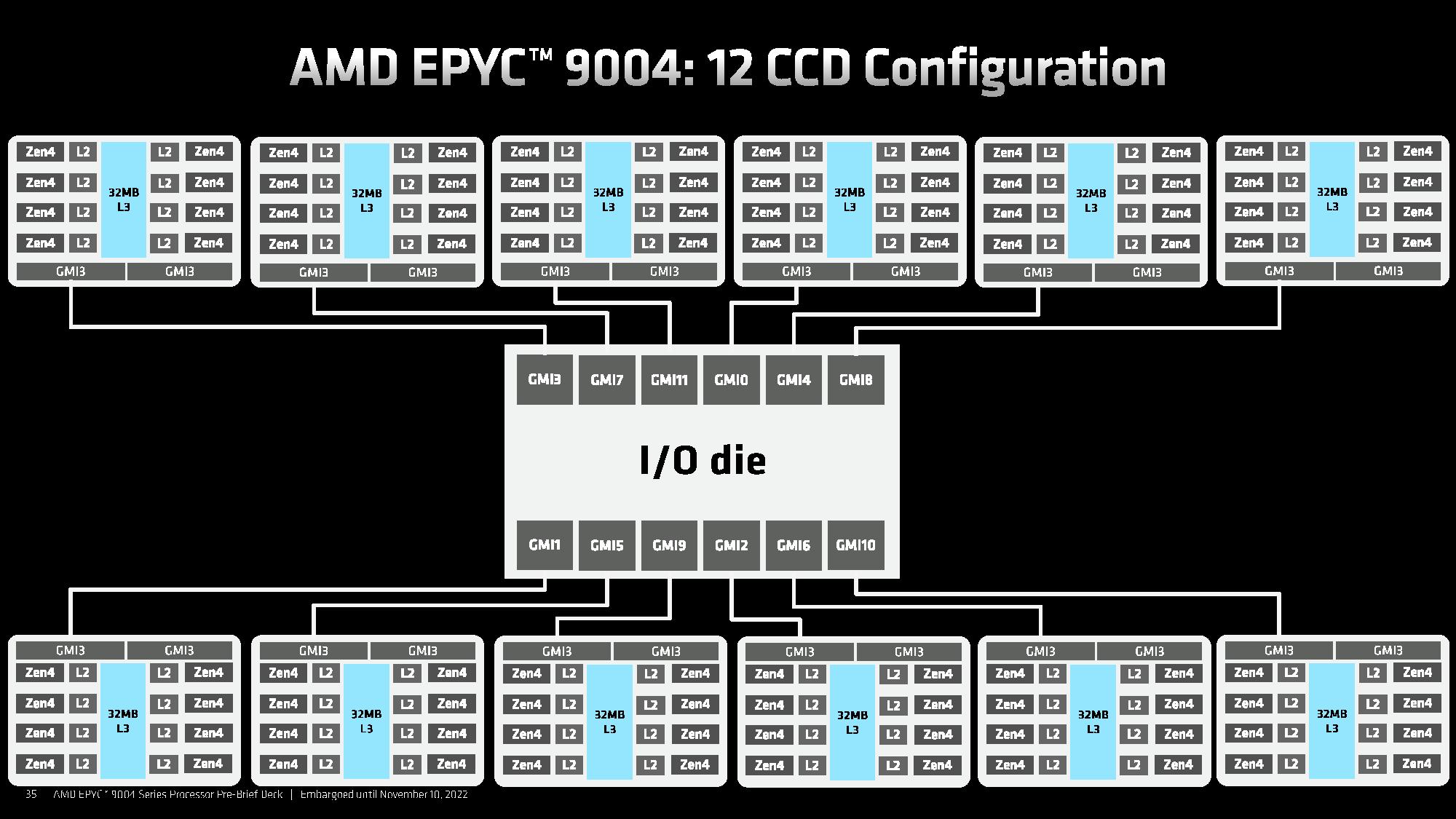
AMD leverages a similar chiplet-based design as we’ve seen with prior-gen EPYC, but moved to more performant GMI3 links between the 6nm I/O die (IOD), which ties the chiplets together and houses the DDR5 and PCIe 5.0 controllers, and the eight-core 5nm Core Complex Dies (CCDs).
Get Tom's Hardware's best news and in-depth reviews, straight to your inbox.
AMD’s previous-gen EPYC had eight Global Memory Interconnect 2 (GMI2) links that supported 8 CCDs, whereas Genoa supports up to 12 CCDs. AMD uses the same IOD for all variants of the EPYC processors, but a different number of CCDs for various SKUs (we included the CCD counts in the table on the first page). As such, lower core-count models with four CCDs can have dual-GMI3 links (wide mode) with the IOD, a new capability that can offer advantages in some throughput-intensive tasks, while larger CCD arrangements use a single GMI3 link per chiplet (narrow mode).
As before, the links provide 32B read and 16B write bandwidth per fabric clock and consume 2 pj/bit (picojoules per bit).
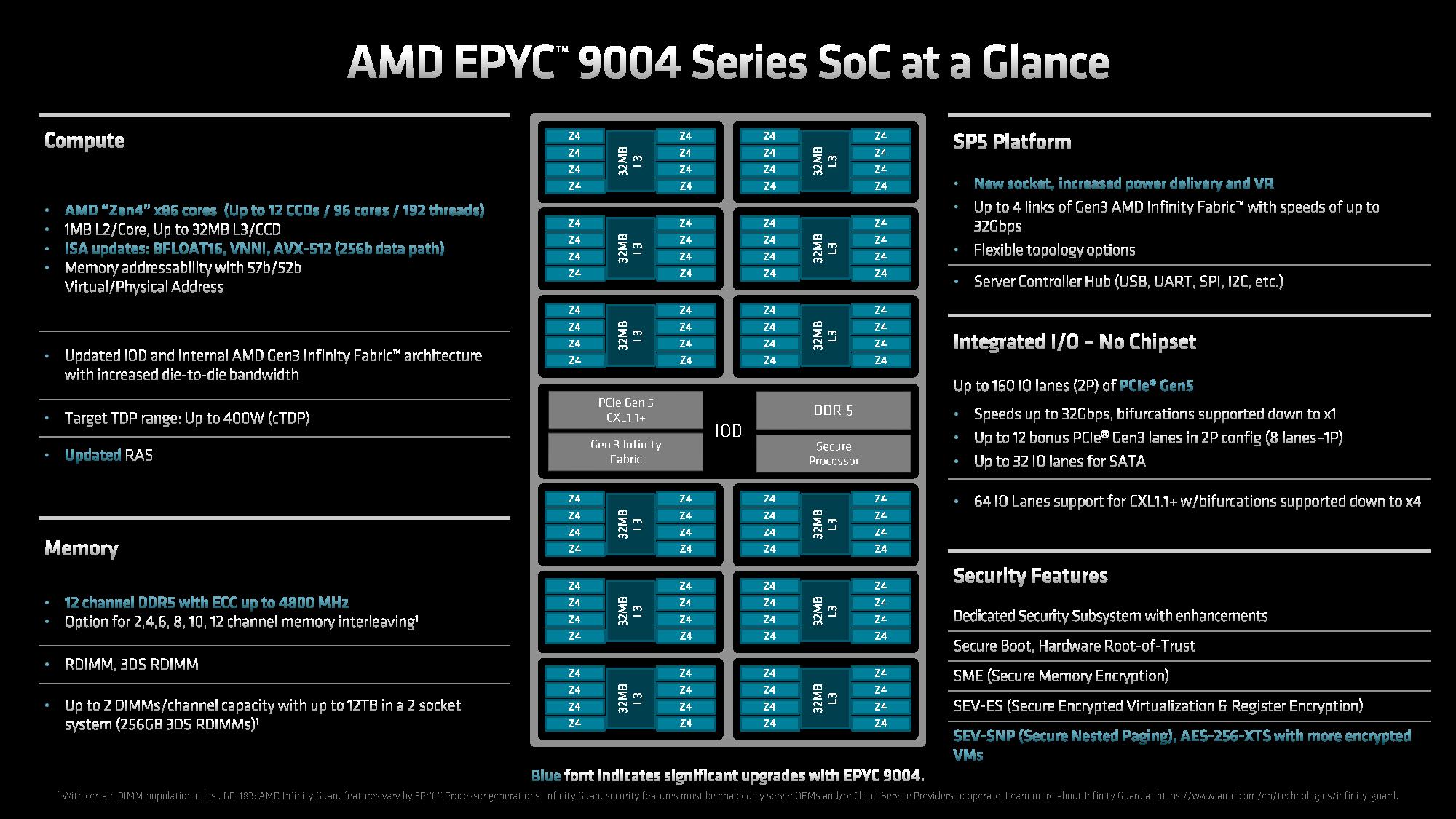
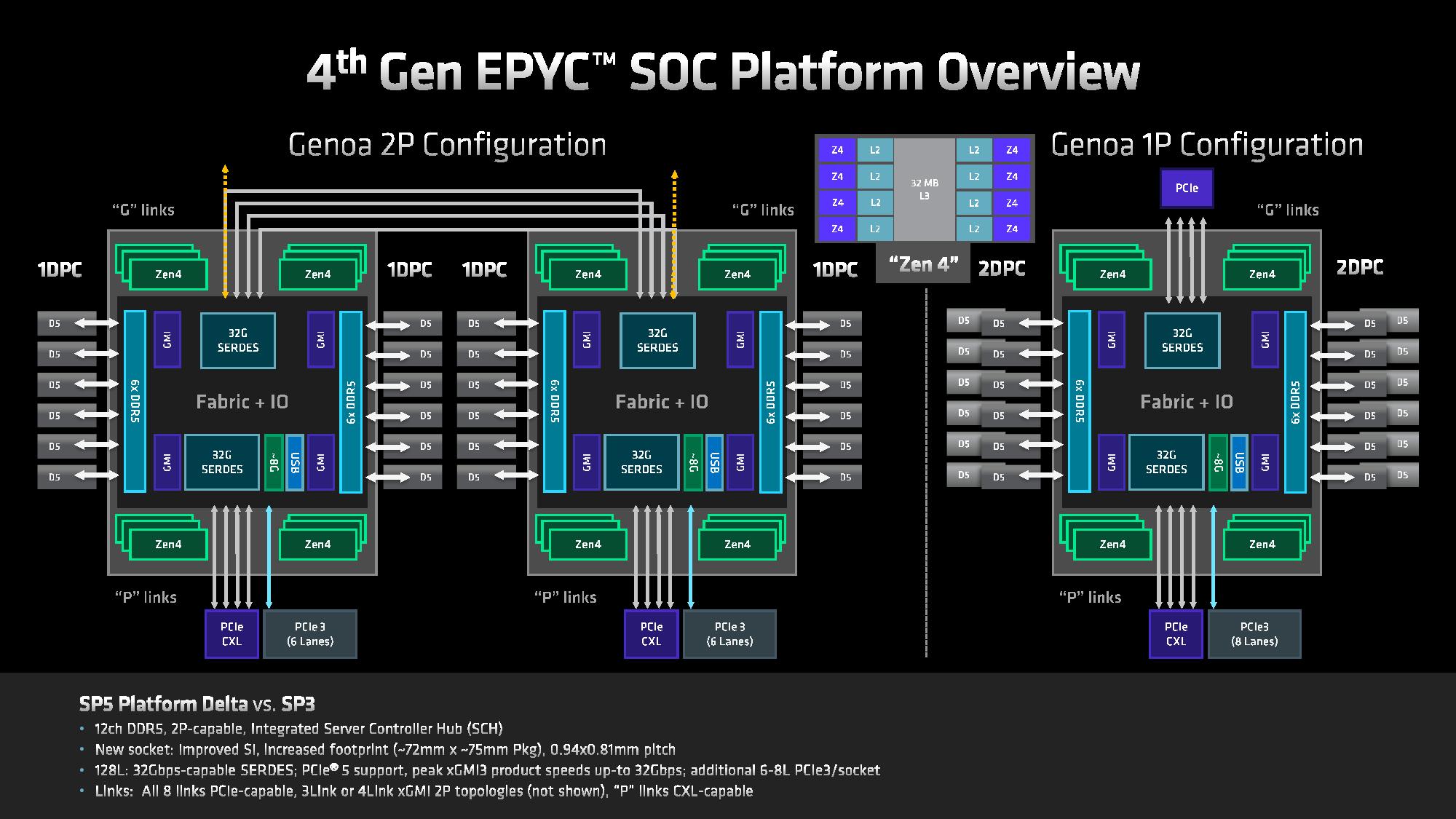
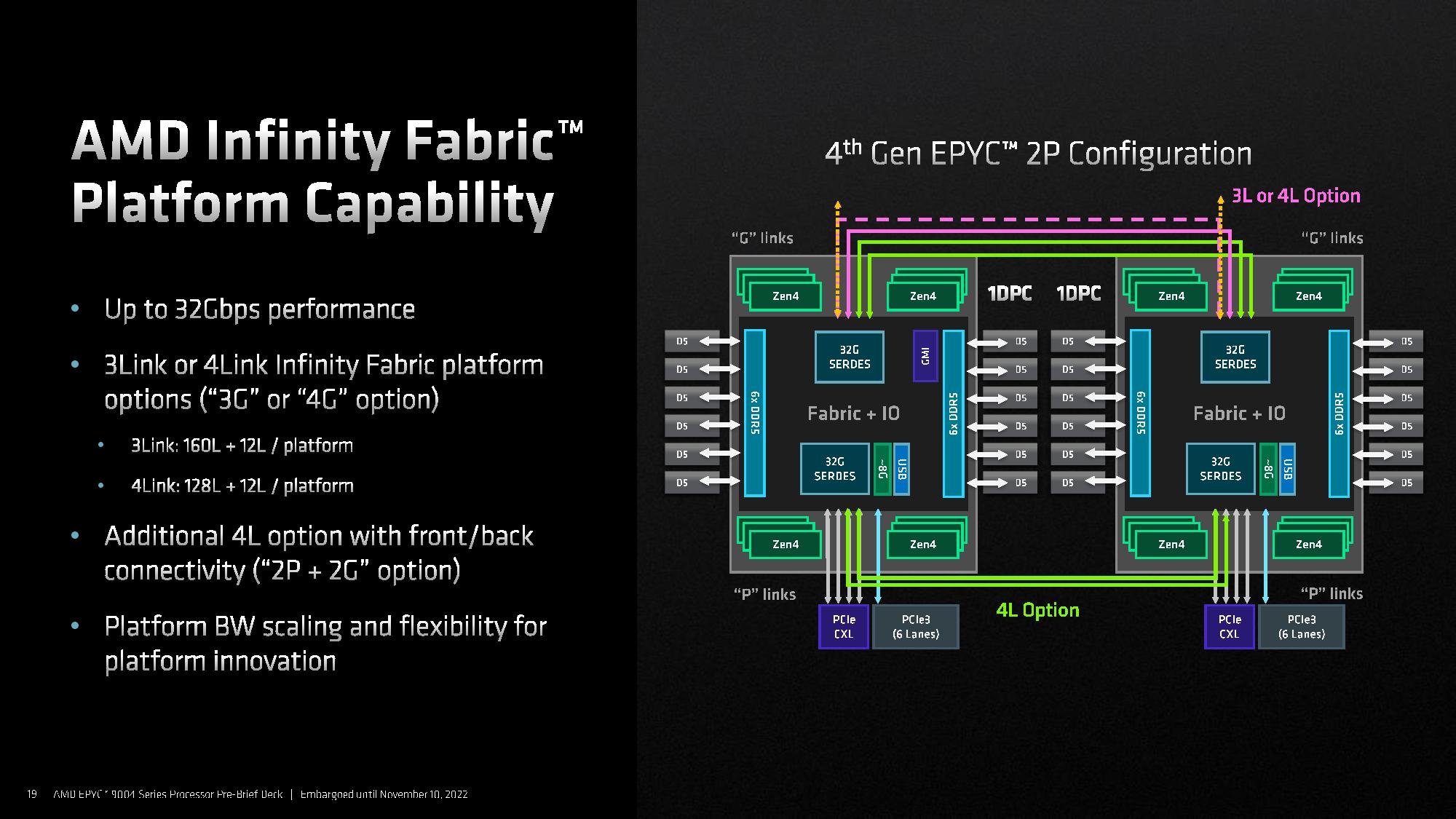
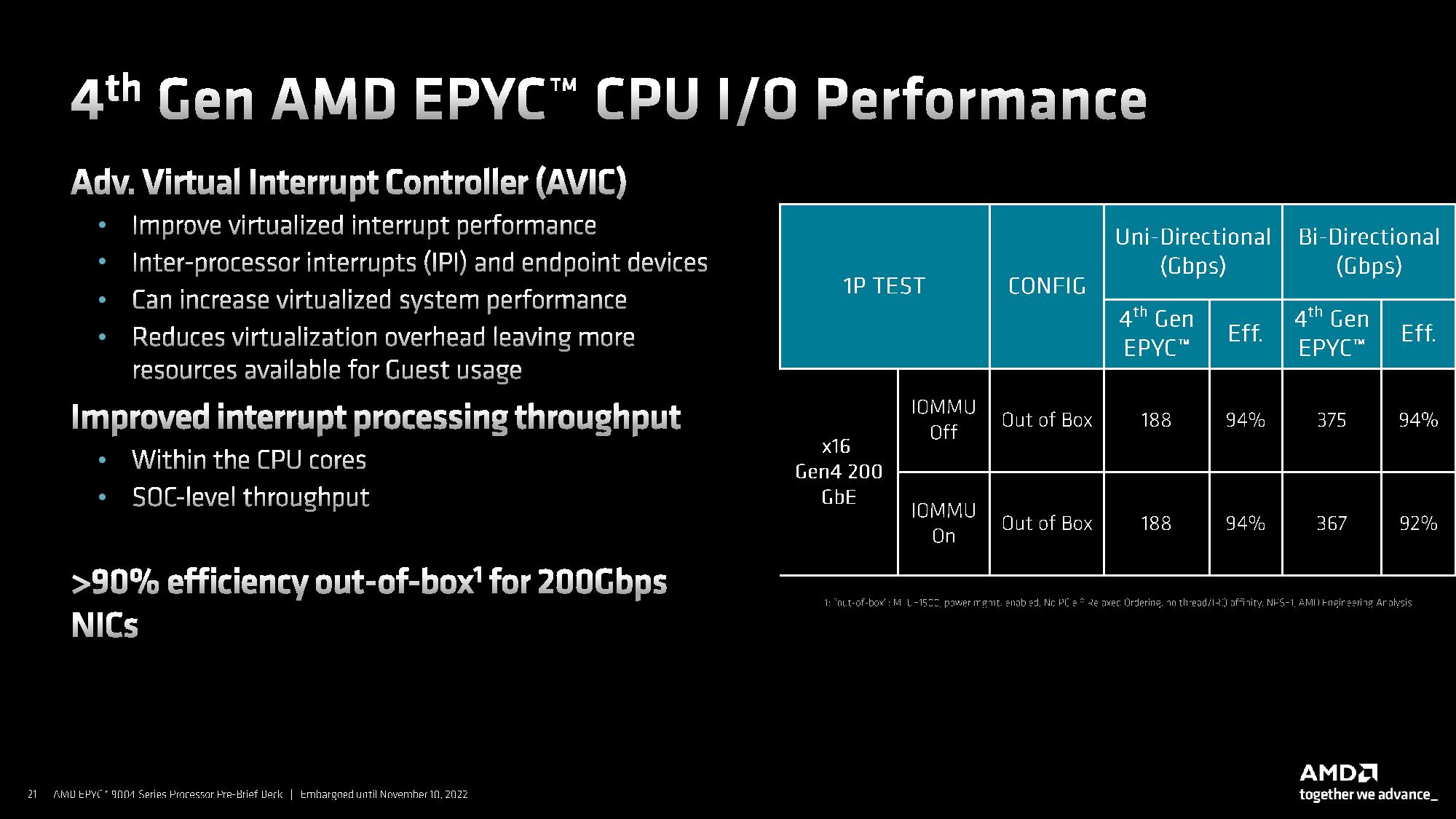
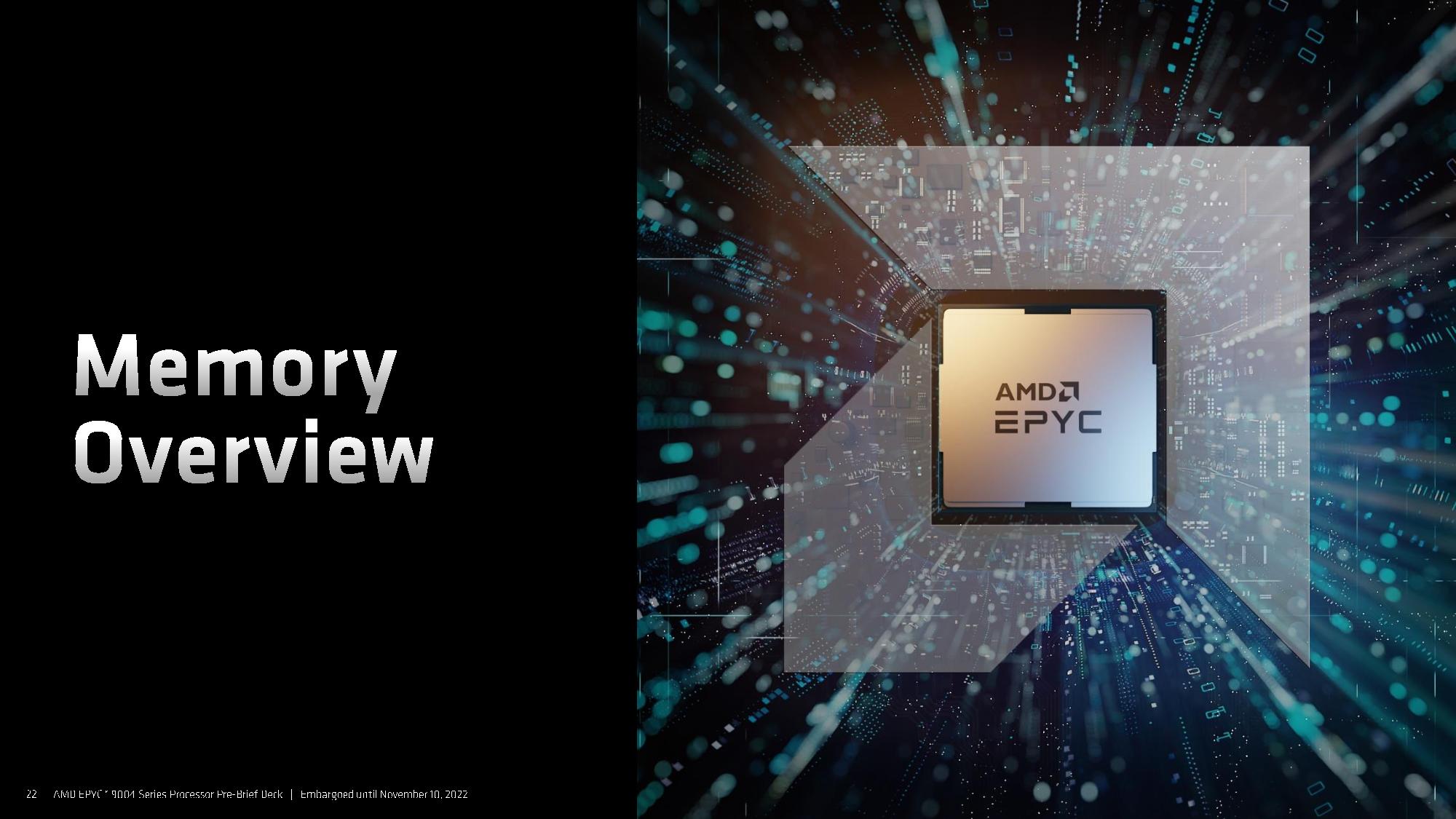

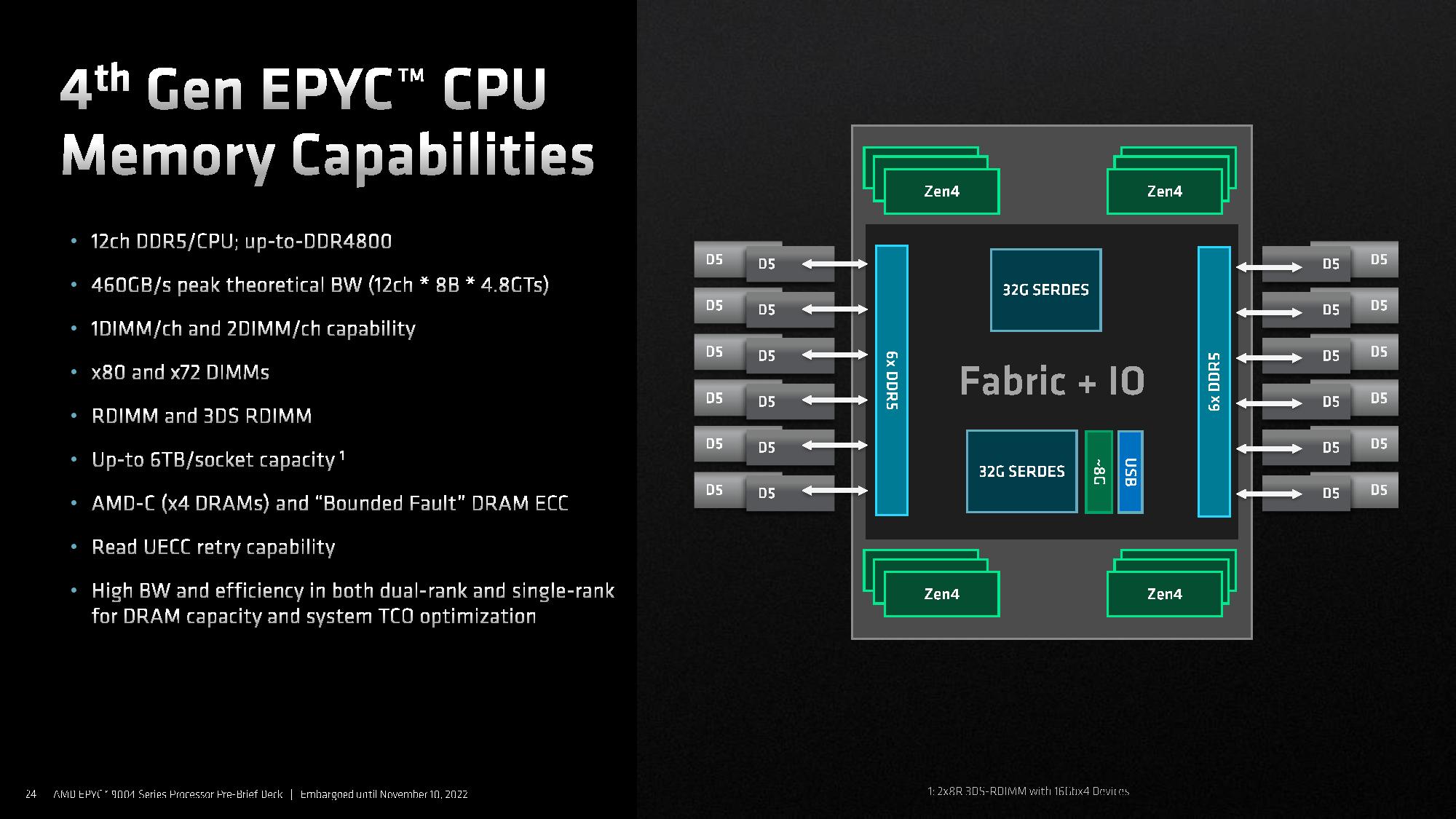






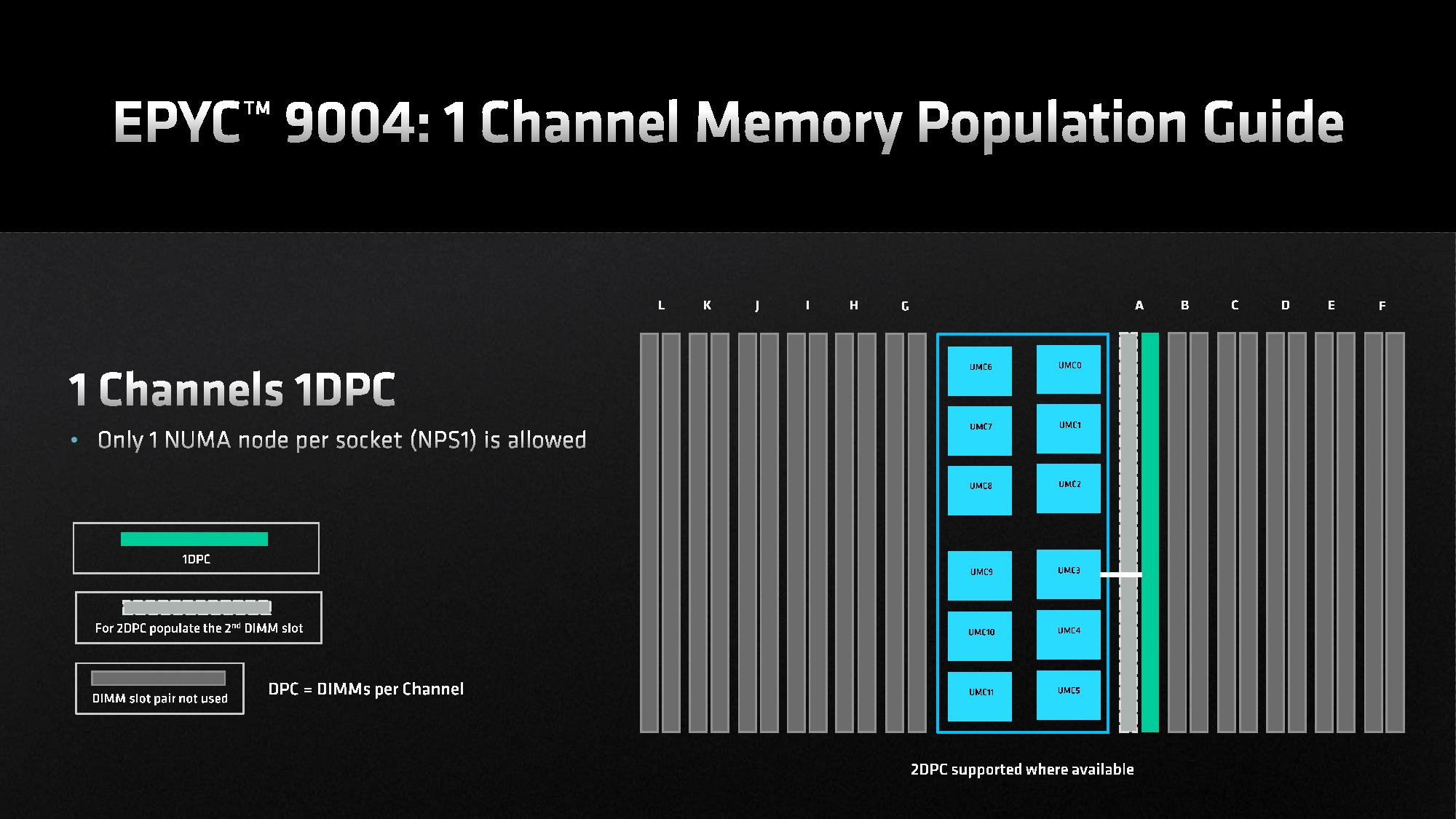
AMD’s new Socket SP5 comes with vastly improved power delivery capabilities courtesy of improved voltage regulators and platform design, which we’ll take a closer look at on the following page. Other improvements include a new flexible Infinity Fabric topology that allows for expanded configuration options for OEMs.
As with Milan and other Socket SP3 EPYC platforms, the two sockets can be connected by either three or four PCIe-based Infinity Fabric links (G Links). A 3Link configuration allows one cross-socket link to be peeled off and dedicated to increasing I/O connectivity for the platform, like more NVMe or networking connections. As such, these links can use cables for custom configurations. However, with SP3 systems, these links are only present at the top of the server (“G” Links), thus requiring long cabling runs that add complexity when provisioning additional I/O on the back panel of the server. With Genoa, AMD added the ability to split those lanes off via cabling at either the top or the bottom of the socket to simplify cabling and improve signal integrity to the rear I/O. The lanes at the bottom of the socket area are referred to as “P Links.”
The transition to a new memory last happened eight years ago, so the move to DDR5 brings about new complexity at every layer of the design process. From the DDR5 memory controllers inside the processor to the traces, slots, redrivers, switches, and even the materials used in motherboard design, DDR5 has an impact that results in increased costs. So naturally, the payoff is doubled throughput, which can deliver massive improvements in bandwidth-sensitive workloads.
EPYC Genoa supports up to 6TB of DDR5 per socket, spread across 12 channels of DDR5 memory running at DDR5-4800 in one DIMM per channel mode (1DPC). AMD hasn’t yet defined the supported 2DPC speeds, but we’re told that will arrive in the first quarter of next year. Given that most motherboard designs are already space-constrained by cramming in 12 channels, AMD feels that qualified support for 1DPC is sufficient for launch.
The peak theoretical throughput for 12 channels of DDR5 weighs in at 460 GB/s, but the actual throughput will vary. In addition, DDR5 comes with higher latency than DDR4, but AMD says that Genoa’s internal pathways provide roughly the same effective latency as the DDR4-powered Milan chips. Overall, AMD says there is a ~13ns penalty for the Genoa implementation compared to Milan.
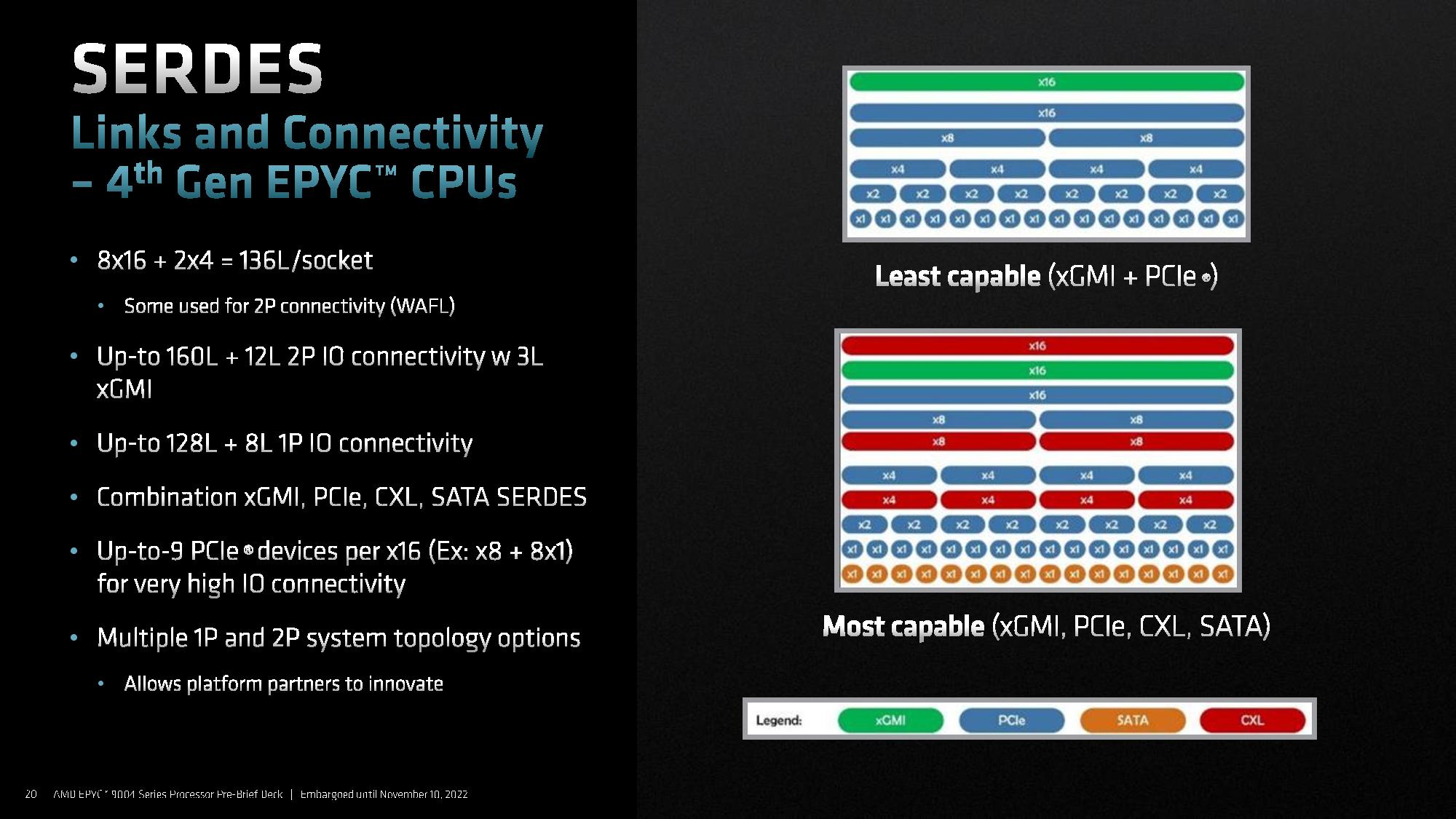
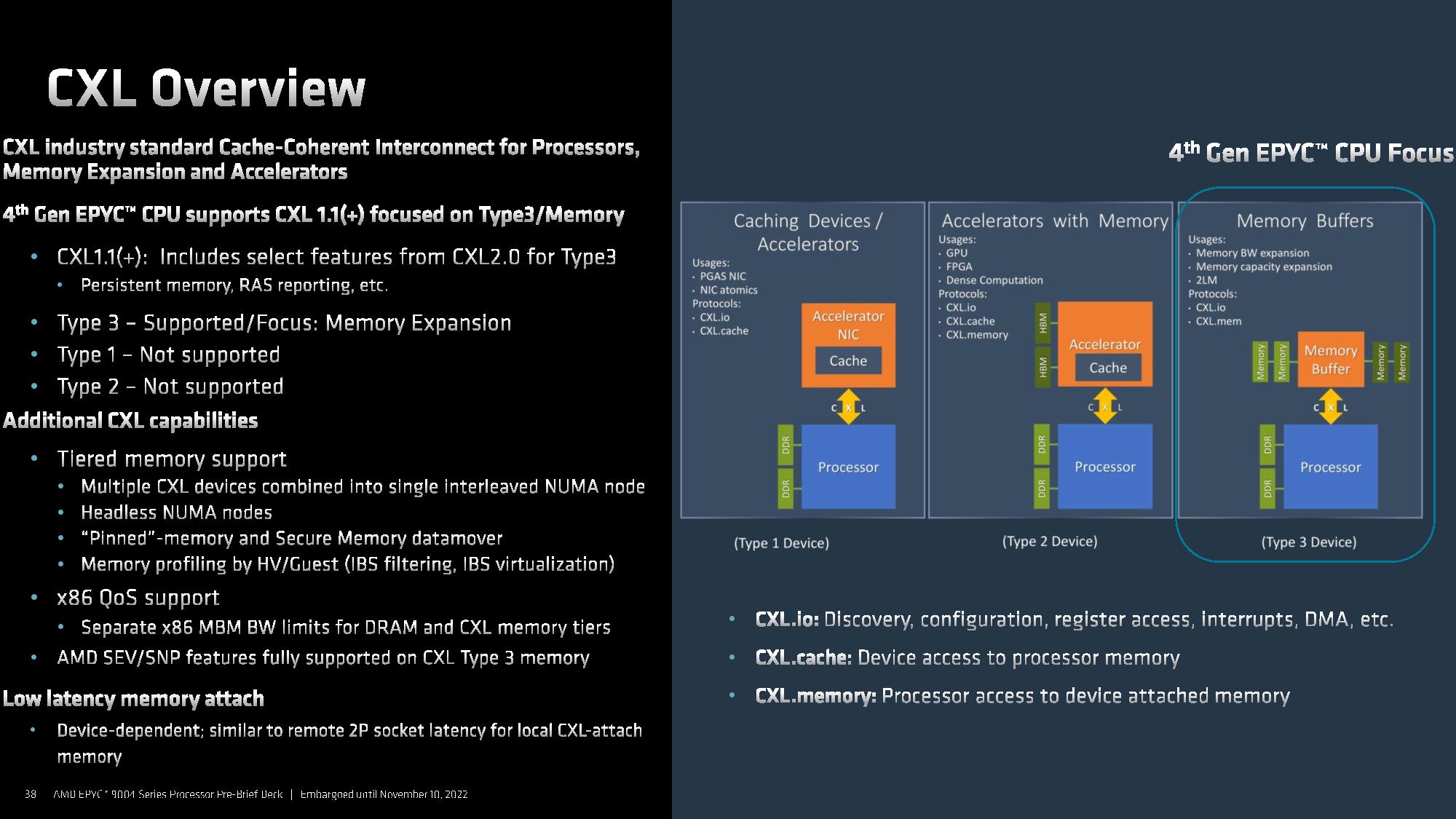
Compute eXpress Link (CXL) is an open industry standard with support from all the major silicon vendors, but it has just emerged over the last few years, and the first devices are finally making their way to market. As a reminder, the CXL 1.0 spec is an open industry standard that provides a cache coherent interconnect between CPUs and accelerators, like GPUs, smart I/O devices, DPUs, and various flavors of DDR4/DDR5 and persistent memories. The interconnect allows the CPU to work on the same memory regions as the connected devices, thus improving performance and power efficiency while reducing software complexity and data movement. This specification currently communicates over the PCIe 5.0 bus, but the CXL 3.0 revision of the spec has already charted a course to PCIe 6.0 support.
The CXL spec has matured rapidly, and CXL 2.0 arrived before widespread support for CXL 1.0 arrived in any meaningful quantities. This specification requires baked-in support at the SERDES level to enable low-latency connections — equivalent to the latency penalty of a single NUMA hop — to remote banks of memory.
As such, AMD had to intercept the new capabilities of the 2.0 spec late in the design stages for Genoa, essentially re-designing its SERDES to support the new features. That resulted in fast yet not-quite-complete support for CXL 2.0. As such, AMD terms its support for CXL as version 1.1+, a similar approach we’ll see with Intel’s Sapphire Rapids.
CXL supports three types of devices, but AMD has focused on adding the most robust support for the most important feature for the industry at large — the Type 3 devices that enable memory expansion. As such, Genoa ropes in the persistent memory and RAS reporting features from CXL 2.0 for Type 3 devices into its CXL 1.1+ implementation.
This capability allows users to address remote memory as local memory. In addition, Genoa allows multiple Type 3 devices to be aggregated into one interleaved NUMA node, and it also supports ‘headless NUMA’ nodes. Other features include QoS mechanisms to account for the latency delta between truly local memory and the CXL memory devices, along with support for AMD’s SEV/SNP security features to protect data.
For now, the leading-edge CXL memory expansion devices slot directly into the PCIe slot, but CXL Type 3 devices will evolve to network-attached memories in the future.
AMD’s SERDES now has two types of connections, with one type of SERDES port supporting the standard xGMI or PCIe interfaces while the other additionally supports more interfaces, like SATA and, more importantly, CXL.
AMD only supports CXL devices on the “P Links” described in the section above, meaning that the connections stem from the links at the bottom of the socket. As you can see in the diagram, AMD supports varying levels of connectivity in its SERDES based on the type of connection.
CXL support peaks at 16 devices in a single socket if they are spread across the x4 connections, but customers can also use x8 and x16 CXL connections. As such, customers can allocate up to 64 of the 128 available PCIe 5.0 lanes to CXL devices.
- MORE: Best CPUs for Gaming
- MORE: CPU Benchmark Hierarchy
- MORE: AMD vs Intel
- MORE: Zen 4 Ryzen 7000 All We Know
Current page: CXL, Zen 4 Architecture, Chiplet Designs
Prev Page AMD 4th-Gen EPYC Genoa 9654, 9554, and 9374F Next Page The SP5 Socket, Titanite Test System, Test Setup
Paul Alcorn is the Editor-in-Chief for Tom's Hardware US. He also writes news and reviews on CPUs, storage, and enterprise hardware.
-
Roland Of Gilead Okay, for those more knowledgeable than me (I'm not really into server tech), how is it that Intel is so far behind in terms of core count with these systems? Looking at some of the benches (and I might as well be blind in both eyes and using a magnifying glass to scroll through the data!) it seems to me that if Intel were able to increase core count, that they would be comparable in performance to the AMD counterparts? What gives?Reply
Intel have taken the performance crown with ADL and Raptor in the consumer market, but on the bigger scales can't get close. -
rasmusdf Well, basically AMD has mastered the art and technology of connecting lots of small chips together. While Intel still has to make chips as one big lump. Big chips are harder and more expensive to produce. Plus when combining small chips you can always and easily add more.Reply
Intel might be competing right now in the consumer space - but they don't earn much profit on their expensive to produce CPUs.
Additionally - AMD is cheating a bit and is several chip nodes ahead in production process - while Intel is struggling to get past 10 nm, AMD is on what, 4 nm? Because of TSMCs impressive technology leadership and Intels stubborness. -
gdmaclew Strange that Tom's mentions that DDR5 support for these new Data Center CPUs is a "Con" but they don't mention it in yesterday's article of Intel's new CPUs using the same DDR5.Reply
But then maybe not, knowing Tom's. It's just so obvious. -
SunMaster ReplyRoland Of Gilead said:Intel have taken the performance crown with ADL and Raptor in the consumer market, but on the bigger scales can't get close.
Rumour has it that AMD prioritize less on the consumer market, and more on the server marked. So if "one core to rule them all" it means Zen4 is a core designed primarily for server chips. Whether Alder Lake took the "performance crown" or not is at best debateable, as is Raptor Lake vs Zen4 if power consumption is taken into consideration.
Intel does not use anything equivalent of chiplets (yet). The die size of raptor lake 13900 is about 257 square mm. Each Zen4 ccd is only 70 square mm (two in a 7950x). That gives AMD a tremendous advantage in manufacturing and cost.
See oMcsW-myRCU:2View: https://www.youtube.com/watch?v=oMcsW-myRCU&t=2sfor some info/estimates on yields and cost of manufacturing. -
bitbucket You have forgotten the face of your father.Reply
Most likely multiple reasons.
1) Intel struggled for a long time trying to reach the 10nm process
This delayed entire product lines for a couple of years and ultimately led to Intel outsourcing some production to TSMC which wasn't struggling to shrink the fabrication process
2) AMD moved to a chiplet strategy long before Intel, which I don't believe has a product for sale using chiplets yet, not sure though
AMD had already been using TSMC as AMD had sold off their manufacturing facilities years before
Large monolitic, high core-count CPUs are harder to make than smaller lower core-count CPUs
- An example is AMD putting two 8-core chiplets in a package (plus IO die) for a product that has 16 cores
- Intel has recently countered this by going with heterogeneous cores in their CPUs; a mix of bigger/faster and smaller/slower cores
- I don't believe that the heterogeneous core strategy has been implemented in servers products yet -
InvalidError The DIMM slot fragility issue could easily be solved or at least greatly improved by molding DIMM slots in pairs for lateral stability and sturdiness.Reply -
Roland Of Gilead Reply
Fair pointSunMaster said:Whether Alder Lake took the "performance crown" or not is at best debateable, as is Raptor Lake vs Zen4 if power consumption is taken into consideration. -
GustavoVanni It is just me or do you guys also think that AMD can fit 24 CCDs in the same package in the not so distant future?Reply
Sure there's some small SMDs in the way, but it should be doable.
Just imagine one of those with 192 ZEN4 cores ou 256+ ZEN4c cores.
Maybe with ZEN5? -
-Fran- Intel's only bastion seems to be accelerators and burn as much money as they can on adoption, even worse than AVX512.Reply
I just looked at the numbers of OpenSSL and I just laughed... Intel is SO screwed for general purpose machines. Their new stuff was needed in the market last year.
Regards.